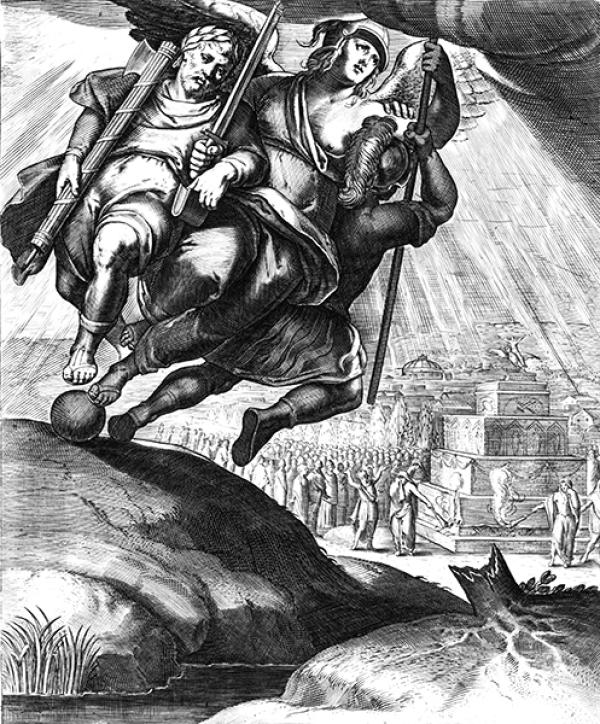
Lesson Plan
Grade Level:
Grades 11 & 12 in AP European History. Assignment can be modified for grade 9 if so desired.
Duration of the lesson:
2-3 days
Content or content standards that the lesson fulfills:
Although this is geared towards meeting requirements on the Renaissance, Scientific Revolution and The Age of Enlightenment in AP European History, it can be used to fulfill 9th grade requirements needed in the above 9th grade curriculum.
Primary Sources:
"The Soul of the World" - Frontispiece to Robert Fludd's book, Utriusque cosmi historia
Websites where original Emblematic images can be found:
Alchemy Website: This site contains many emblematic images that can be used for power points or as discussion of what these images look like.
Alciato's Book of Emblems - The Order of the Emblems: Here can be found the complete text of Andrea Alciato's "Book of Emblems." It contains all 212 of his Emblems and can be read in Latin or English. It contains a mottos (short proverbs), images, poems, and an epigrammatic text.
Emblem Project Utrecht: The site includes 27 Dutch love emblem books, religious as well as secular. For all of these there are full transcriptions, page facsimiles and indexes, as well as extented search options, links to sources and parallels, translations, and annotations.
Sources for Additional Information:
Robert Fludd: Complete Dictionary of Scientific Biography (2008). (available at encyclopedia.com)
Alchemy:
“A Brief History of Alchemy” from the University of Bristol School of Chemestry
“Alchemists: Ancient & Modern” The Economist, 24 February 2011.
Blackwell Essential Readings in History: Scientific Revolution, Edited by Marcus Hellyer. Blackwell Publishers Ltd., 2003.
Summary of the lesson:
The use of emblematic images have been viewed as one of the most significant ways in which 16th and 17th century man looked at his natural world. It was an attempt to view and explain hidden meanings of the world with use of wood-cut images, and in some case poems and mottos.
Starting to with the father of Emblematic Images, Andrea Alciato, and continuing to the complex drawings used by Robert Fludd, students will see how these images spoke to the people of this time in a way that few other art forms could.
Description of the instructional steps to implement the lesson:
In AP European History this lesson will be used in the unit I call Age of Genius (Scientific Revolution). Since some of the information used here pertains to the Renaissance, it could be used in that unit, also.
1. Show students the power point Emblematic Images in the Age of Genius, in which students will view a variety of Emblematic Images from various artists. (On the HTI/Goldberg Center page on Slideshare). The power point presents notes on how these images were part of the attempt by people of the eras of the Renaissance and Scientific Revolution to explain the natural world around them. Include in this a short discussion of how Alchemy played into the use of Emblematic Images.
2. After students understand the importance of Emblematic Images they will get a handout of an emblematic image, "The Soul of the World," the frontispiece to Robert Fludd's book, Utriusque cosmi historia.
3. Students will interpret images presented in this piece and discuss them in class.
4. Students will be directed websites (see list above) to view three Emblematic Images by various authors/artists and will use the Document Analysis Worksheet to analyze them.
5. Students will create their own emblematic image on an 8 1/2 x 11 sheet of paper (or larger) or they may create a digital image. These images will then be presented to the rest of the class and discussed.
Result from analyzing the sources:
As a result of analyzing these three Emblematic Images, students will get a better understanding as to the importance of these images to the 16th/17th century mind.
A post assessment will be in the following:
The Analysis Worksheet will be given a homework grade of 25 points if fully completed.
The original emblematic image the student creates, either hand drawn or done digitally will be given a homework grade of 25 points. The grade will not be based its artistic merits but its originality and the students presentation of it to the rest of the class.
Three multiple choice questions concerning Emblematic Images will be given on the final assessment test on the Age of Genius (Scientific Revolution) given at the end of the unit. Here are the Questions.
A short Frequent Response question will asked in which the student will have to answer a question stating the importance of Emblematic Images to the 16th/17th century mind. Finally, here is an optional Interpretive Essay Question.
There is an answer key to all of the above.
Materials needed by the teacher:
Materials needed by the students:
HTI Document Analysis Worksheet Handout, 8 1/2 by 11 sheet of paper or larger (or any digital program that they might want to use to create their Emblematic Image), colored pencils or crayons to color and label their art work.
Ideas for students to continue learning on the topic:
Although Emblematic Images went out of style in the late 17th century and beyond; their importance can still be seen by the way they can be used to view concepts from other time periods in history.
Created by Dale Shilling
